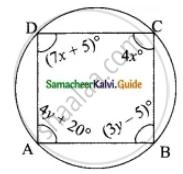Advertisements
Advertisements
Question
ABCD is a cyclic quadrilateral such that ∠A = (4y + 20)°, ∠B = (3y − 5)°, ∠C = (4x)° and ∠D = (7x + 5)°. Find the four angles
Solution

ABCD is a cyclic quadrilateral ∠A + ∠C = 180° ......(Sum of the opposite angles of a cyclic quadrilateral is 180°)
(4y + 20)° + (4x)° = 180°
4y + 20 + 4x = 180
4x + 4y = 180 – 20
4x + 4y = 160
x + y = 40 → (1) ...(divided by 4)
∠B + ∠D = 180° ...(Sum of the opposite angles of a cyclic quadrilateral)
(3y – 5)° + (7x + 5)° = 180°
3y – 5 + 7x + 5 = 180
7x + 3y = 180 → (2)
(1) × 3 ⇒ 3x + 3y = 120 → (3)
(3) – (2) ⇒ – 4x = – 60
4x = 60
x = `60/4`
Substitute the value of x = 15 in (1)
15 + y = 40
y = 40 – 15 = 25
∠A = 4y + 20 = 4(25) + 20 = 100 + 20 = 120°
∴ ∠A = 120°
∠B = 3y – 5 = 3(25) – 5 = 75 – 5 = 70
∴ ∠B = 70°
∠C = 4x = 4(15) = 60
∴ ∠C = 60
∠D = 7x + 5 = 7(15) + 5
∠D = 105 + 5 = 110°
∴ ∠A = 120°, ∠B = 70°, ∠C = 60° and ∠D = 110°
APPEARS IN
RELATED QUESTIONS
The sum of a two digit number and the number formed by interchanging the digits is 110. If 10 is subtracted from the first number, the new number is 4 more than 5 times the sums of the digits of the first number. Find the first number.
The sum of the numerator and denominator of a fraction is 12. If the denominator is increased by 3, the fraction becomes `1/2`. Find the fraction
On selling a T.V. at 5% gain and a fridge at 10% gain, a shopkeeper gains ₹ 2000. But if he sells the T.V. at 10% gain and the fridge at 5% loss, he gains Rs. 1500 on the transaction. Find the actual price of the T.V. and the fridge.
Two numbers are in the ratio 5 : 6. If 8 is subtracted from each of the numbers, the ratio becomes 4 : 5. Find the numbers.
4 Indians and 4 Chinese can do a piece of work in 3 days. While 2 Indians and 5 Chinese can finish it in 4 days. How long would it take for 1 Indian to do it? How long would it take for 1 Chinese to do it?
Which of the following is not a linear equation in two variable
